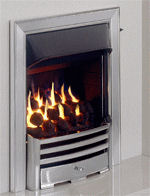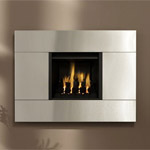What type of gas fire can I have?
Back to Help and Advice
Click here for fireplaces
What are the differences in depths of a fuel bed?
Deep Fuel Beds (also known as Class 1 Chimney Gas Fires)
Deep fuel beds, or full depth fuel beds are found on fires designed for homes with brick built chimneys or prefabricated flues. Brick built chimneys are common in pre-1960 homes. Deep fuel bed gas fires are intended for use with Class 1 chimneys. Please always check with a qualified installer to make sure your chimney is suitable for your chosen product.
Slimline Fuel Beds (also known as Class 2 Chimney Gas Fires)

Slimline fuel beds are found on slimline fires, also referred to as Class 2 chimney fires, flat wall fires, or multi-flue fires. Slimline fuel beds are usually at least 10cm/ 4 inches shallower than the full depth fuel beds. Slimline fuel beds are suitable for most chimney/flue types. Please always check with a qualified installer to make sure your chimney is suitable for your chosen gas fire.
What are the different gas fire styles?
Contemporary Gas Fires

Contemporary gas fires offer a huge range of options to suit modern interiors. As well as inset fires to go into a fireplace, there are hang-on-the-wall and hole-in-the-wall fires which can be installed without a hearth. Trims and fascias are available in a wide range of finishes including chrome, brushed steel, stainless steel and stone. It is also common to have a choice of fuel effect, such as pebbles, logs, charcoal and coal. With such a wide variety of options you are sure to find the ideal modern gas fire for your home.
Traditional Gas Fires

Traditional gas fires are designed to suit period and classically designed interiors. Most traditional inset gas fires fit into a standard size opening (Height 22", Width 16"). The most common finishes are black and brass and many of these fires have magnetic trims, allowing easy maintenance and to change the fire appearnce you can simply change the trims. Some traditional gas fires have one-piece fascia frames, usually made of cast iron, which suit cast iron back panels, or dark marble interiors.
Wall Mounted Gas Fires

Wall mounted gas fires, also known as hang-on-the-wall gas fires, are increasingly popular in modern homes. They are available in a large range of sizes and styles, and can usually be installed without a hearth (subject to manufacturers' guidance) - a huge space saver in smaller rooms. Open fronted wall fires lose heat up the chimney and for this reason they are usually bought as decorative features rather than as a main heat source. Glass fronted wall fires generally give out more heat because the combustion products circulate the fire bed for longer.
Outset Gas Fires

Outset gas fires offer impressive heat outputs, and are suitable for most chimney or flue types. Installation can be performed within a fireplace, standing on a hearth, or wall hung without a surround. Outset fires tend to be traditionally styled and some have wood casings that match your furniture. Common options include high level switches (popular with elderly people) and radiant and convector models.
Glass Fronted Gas Fires

Glass fronted glass fires offer higher efficiency, meaning they are eco-friendly and reduce home fuel bills. They are available in many styles including inset and hole-in-the-wall, often with a choice of fuel bed. The glass panels are easy to remove for annual maintenance. Families with small children often opt for this type of fire, but please note the glass front will get very hot when in use. Care should be taken to prevent children getting too close, for example use of a suitable fire guard.
What type of gas fire can I have if I don't have a chimney?
Most new build homes in UK don't have a conventional chimney, but there are new gas fire models available that can . While this used to limit householders to electric fires, there are now many gas fires available which don't require a chimney.
Balanced Flue Gas Fires

Balanced flue gas fires are glass fronted and available as both inset and outset models. Balanced flue gas fires vent directly through an external wall by means of a horizontal co-axial pipe (one pipe within another). Air is drawn in through the outer pipe, and combustion gases are expelled through the inner pipe. Balanced flue fires do not require an electricity supply.
Powerflue & Fan Flue Gas Fires

Powerflue gas fires are available as both inset and outset models and do not require a glass front. Flue gases are vented through an external wall, drawn out by an electronically driven fan unit. The fan unit is controlled by a sophisticated microprocessor which monitors performance and shuts off the fire in the unlikely event of an operation failure. Powerflue fires require an electricity supply.
Flueless Gas Fires Flueless gas fires work without any kind of chimney or flue, and don't need to be installed on an external wall. As the fire burns, combustion gases pass through a catalytic converter within the appliance. This converts poisonous carbon monoxide into harmless carbon dioxide and water vapour, which can safely be released back into the room. Flueless gas fires do require a minimum room size and fixed ventilation, please consult your qualified gas fitter before purchase.
Controls Most gas fires are fitted with manual controls as standard. They often have the option to upgrade to either a slide control, where operation of the gas fire is controlled by a lever at the top of the appliance, which is ideal for older users. Hand held remote controls, which are optional on many gas fires, mean that the fire can be controlled from the comfort of your armchair.



















